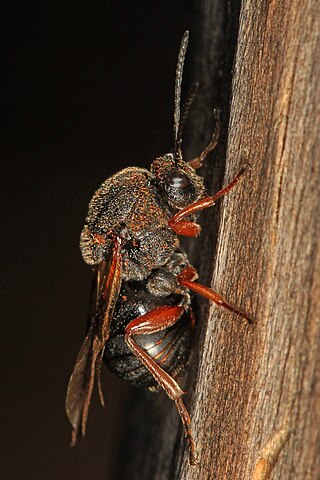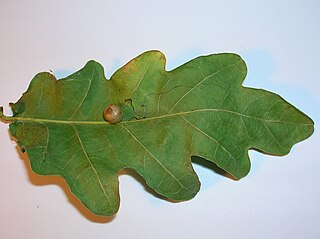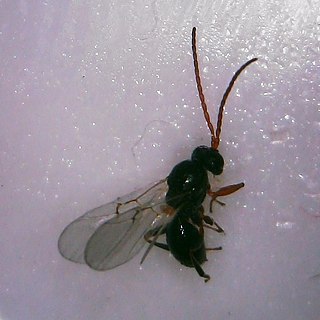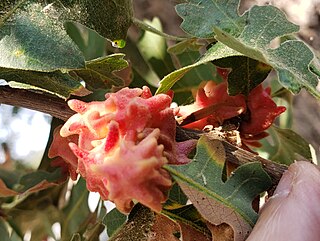Galls or cecidia are a kind of swelling growth on the external tissues of plants. Plant galls are abnormal outgrowths of plant tissues, similar to benign tumors or warts in animals. They can be caused by various parasites, from viruses, fungi and bacteria, to other plants, insects and mites. Plant galls are often highly organized structures so that the cause of the gall can often be determined without the actual agent being identified. This applies particularly to insect and mite plant galls. The study of plant galls is known as cecidology.

Gall wasps, also traditionally calledgallflies, are hymenopterans of the family Cynipidae in the wasp superfamily Cynipoidea. Their common name comes from the galls they induce on plants for larval development. About 1,300 species of this generally very small creature are known worldwide, with about 360 species of 36 different genera in Europe and some 800 species in North America.
Asiconops is a subgenus of flies from the genus Conops in the family Conopidae.

The red-pea gall or red currant gall develops as a chemically induced distortion arising from the underside of the mid-rib of a vein on Quercus species and it is attached by a short stalk or peduncle. The red-wart gall is the sexual phase of the same species.
Lauterborniella is a genus of European non-biting midges in the subfamily Chironominae of the bloodworm family Chironomidae.

Cynips is a genus of gall wasps in the tribe Cynipini, the oak gall wasps. One of the best known is the common oak gall wasp, which induces characteristic spherical galls about two centimeters wide on the undersides of oak leaves.

Cynips quercusfolii, also known as the cherry gall wasp, is a gall wasp species in the genus Cynips and family Cynipidae. The species is important for the production of commercial nutgall formed on Quercus lusitanica . Galls are located on the underside of leaves, with the majority of galls being on the second and third veins from the petiole of the leaf.
In the 10th edition of Systema Naturae, Carl Linnaeus classified the arthropods, including insects, arachnids and crustaceans, among his class "Insecta". Insects with membranous wings, including bees, wasps and ants were brought together under the name Hymenoptera.

Casaleia is an extinct genus of ants in the formicid subfamily Amblyoponinae described by Pagliano & Scaramozzino in 1990 from fossils found in Europe. The genus contains four species dating from the Eocene to Miocene, Casaleia eocenica, Casaleia inversa, Casaleia longiventris, Casaleia orientalis.

Tipula longiventris is a species of large crane fly in the family Tipulidae.
Elachiptera longiventris is a species of frit fly in the family Chloropidae.

Andricus dimorphus, also called the clustered midrib gall wasp, is a species of oak gall wasp in the family Cynipidae. Galls in which the larvae live and feed are formed in clusters along the midrib on the underside of oak leaves.

Cynips douglasii, the spined turbaned gall wasp, is a species of gall wasp in the family Cynipidae. It induces galls in valley oaks, blue oak, and scrub oaks. These galls are noted for their spines and can be white, purple, or pink. They can be up to 15 mm high and 10 mm wide. For the unisexual generation, female adult wasps emerge from the galls in January and February. The smaller bisexual generation emerges in spring and produces rounder galls.

Andricus quercuspetiolicola, also called the oak petiole gall wasp, is a species of oak gall wasp in the family Cynipidae. Galls in which the larvae live and feed are formed along the midrib or petiole of white oak leaves.

Cynips quercusechinus, the urchin gall wasp, is a species of gall wasp in the family Cynipidae. It induces galls in the leaves and leaf buds of blue oak and scrub oak. Like other oak gall wasps, it has two generations: a bisexual generation, and a parthenogenic female generation. In spring, the hatching bisexual generation produces hollow green galls in leaf buds. In summer, the unisexual generation induces its galls, which are red or pink and resemble sea urchins, on the undersides of leaves. These galls are about 10 millimetres (0.39 in) in diameter. The galls fall with the leaves in autumn, and the larvae inside of them emerge as adults in the spring and lay their eggs.
Psednos longiventris is a species of snailfish found in the south-western Pacific Ocean.

Besbicus is a genus of gall-inducing cynipid wasp found in North America. Several species now classed as Besbicus were formerly considered to be a part of the genus Cynips. Besbicus was originally described as a subgenus by Alfred Kinsey in 1929. Circa 2010, one group of entomologists noted that it was "possible that the nearctic genera Antron and Besbicus were erroneously synonymized to Cynips".

Besbicus conspicuus, formerly Cynips conspicuus, also known as the fuzzy gall wasp, is a common species of cynipid wasp that induces globular stem galls on white oak trees on the west coast of North America. This gall is solid but for the central larval chamber. After the wasp emerges, beetles sometimes chew through the husk to consume the tissue inside. Besbicus conspicuus galls are sometimes mistaken for Disholcaspis washingtonensis galls. This wasp is found west of the Sierra Nevada range in California in North America.

Besbicus multipunctatus, formerly Cynips multipunctatus, also known as the gray midrib gall wasp, is a common species of cynipid wasp that induces galls on oak trees on the west coast of North America. The wasp oviposits on the midrib of the underside of blue oak leaves. The galls induced by this wasp are solid, except for the large central larval chamber, and are detachable. This wasp is found primarily, but not exclusively, in California.

Besbicus heldae, formerly Cynips heldae, also known as the thorny gall wasp or thorn gall wasp, is an uncommon species of cynipid wasp that induces bud galls on Oregon oak and valley oak trees on the west coast of North America. Fresh gall are rose pink, measure 6–16 mm in diameter, and have a "mealy-granular" surface and possibly overlapping, disorderly looking "spikes". Galls are detachable and turn brown as they age. This gall superficially resembles the galls induced by Burnettweldia corallina or Cynips quercusechinus.













